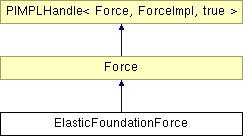ElasticFoundationForce Class Reference
This class implements an elastic foundation or "bed of springs" contact model. More...
#include <ElasticFoundationForce.h>

Public Member Functions | |
| ElasticFoundationForce (GeneralForceSubsystem &forces, GeneralContactSubsystem &contacts, ContactSetIndex contactSet) | |
| Create an elastic foundation contact model. | |
| void | setBodyParameters (int bodyIndex, Real stiffness, Real dissipation, Real staticFriction, Real dynamicFriction, Real viscousFriction) |
| Set the material parameters for a body in the contact set, which must be a ContactGeometry::TriangleMesh. | |
| Real | getTransitionVelocity () const |
| Get the transition velocity (vt) of the friction model. | |
| void | setTransitionVelocity (Real v) |
| Set the transition velocity (vt) of the friction model. | |
| SimTK_INSERT_DERIVED_HANDLE_DECLARATIONS (ElasticFoundationForce, ElasticFoundationForceImpl, Force) | |
Detailed Description
This class implements an elastic foundation or "bed of springs" contact model.
It places springs over the surface of a triangle mesh, each of which independently interacts with objects in contact with the mesh. The interaction includes components for the normal restoring force, dissipation in the material, and surface friction. This force is only applied to contacts involving a triangle mesh, though the object colliding with the mesh may be of any type. Contacts which do not involve a triangle mesh are ignored.
This class relies on a GeneralContactSubsystem to identify contacts, then applies forces to all contacts in a single contact set. To use it, do the following:
- Add a GeneralContactSubsystem and GeneralForceSubsystem to a MultibodySystem.
- Create a contact set within the GeneralContactSubsystem, and add ContactGeometry objects to it.
- Add an ElasticFoundationForce to the GeneralForceSubsystem, and call setBodyParameters() on it once for each TriangleMesh in the contact set.
A spring is placed at the center of each face of each triangle mesh. When a mesh collides with any other object, the other object is considered to be rigid and the displacement of each spring is calculated independently. A spring is considered to be displaced if its base location is inside the other object, and the contact point is taken to be the nearest point on that object's surface. When two meshes collide, the springs on each mesh are treated independently: each mesh is assumed to be rigid for purposes of calculating the force exerted by the other mesh's springs.
Normal Force Components
The force exerted by each spring along its displacement direction is given by
f = k*a*(x+c*v)
where k is the spring stiffness, a is the area of the face the spring belongs to, x is the displacement distance, c is the spring's dissipation coefficient, and v=dx/dt. If the springs are assumed to represent a uniform layer of elastic material over a rigid substrate, the stiffness is given by
k = (1-p)*E/((1+p)(1-2p)*h)
where E is the Young's modulus of the elastic layer, p is its Poisson's ratio, and h is its thickness.
Friction Force
The friction force exerted by each spring is based on a model by Michael Hollars:
f = fn*[min(vs/vt,1)*(ud+2(us-ud)/(1+(vs/vt)^2))+uv*vs]
where fn is the normal force at the contact point, vs is the slip (tangential) velocity of the two bodies at the contact point, vt is a transition velocity (see below), and us, ud, and uv are the coefficients of static, dynamic, and viscous friction respectively.
Because the friction force is a continuous function of the slip velocity, this model cannot represent stiction; as long as a tangential force is applied, the two bodies will move relative to each other. There will always be a nonzero drift, no matter how small the force is. The transition velocity vt acts as an upper limit on the drift velocity. By setting vt to a sufficiently small value, the drift velocity can be made arbitrarily small, at the cost of making the equations of motion very stiff. The default value of vt is 0.01.
Constructor & Destructor Documentation
| ElasticFoundationForce | ( | GeneralForceSubsystem & | forces, | |
| GeneralContactSubsystem & | contacts, | |||
| ContactSetIndex | contactSet | |||
| ) |
Create an elastic foundation contact model.
- Parameters:
-
forces the subsystem which will own this ElasticFoundationForce element contacts the subsystem to which this contact model should be applied contactSet the index of the contact set to which this contact model will be applied
Member Function Documentation
| Real getTransitionVelocity | ( | ) | const |
Get the transition velocity (vt) of the friction model.
| void setBodyParameters | ( | int | bodyIndex, | |
| Real | stiffness, | |||
| Real | dissipation, | |||
| Real | staticFriction, | |||
| Real | dynamicFriction, | |||
| Real | viscousFriction | |||
| ) |
Set the material parameters for a body in the contact set, which must be a ContactGeometry::TriangleMesh.
- Parameters:
-
bodyIndex the index of the body within the contact set stiffness the stiffness constant (k) for the body dissipation the dissipation coefficient (c) for the body staticFriction the coefficient of static friction (us) for the body dynamicFriction the coefficient of dynamic friction (ud) for the body viscousFriction the coefficient of viscous friction (uv) for the body
| void setTransitionVelocity | ( | Real | v | ) |
Set the transition velocity (vt) of the friction model.
| SimTK_INSERT_DERIVED_HANDLE_DECLARATIONS | ( | ElasticFoundationForce | , | |
| ElasticFoundationForceImpl | , | |||
| Force | ||||
| ) |
The documentation for this class was generated from the following file:
 1.6.1
1.6.1